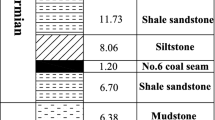Abstract
Accurately gauging the risk of water inrush from underlying aquifers is paramount for ensuring safety in coal mine production. This paper presents an Improved Vulnerability Index Model for water-inrush (IVIM), a risk evaluation system built upon eight factors influencing coal-floor water inrush events. Firstly, the Combined Weight Method (CWM) was utilized to establish static comprehensive weights. Then, the Dynamic Weight Theory (DWT) facilitated the construction of a zoning variable weight model to determine the dynamic weights of controlling factors. Finally, the Uncertainty Analysis Model (UAM) was employed to create a linear uncertainty measure function for determining risk levels. The model was applied to the Qipanjing Mine in Inner Mongolia and compared against the Traditional Vulnerability Index Model (TVIM). Results indicated higher inrush risks in the southern and western parts of the study area compared to the eastern and northern sections, with geological structural regions exhibiting significantly greater risks. Monitoring water pressure and detecting fracture structures represent critical priorities. Compared to TVIM, IVIM yielded a 28% proportion of relative danger and danger zones, surpassing the 19% identified by TVIM. The model’s effectiveness was validated utilizing the Fitting Rate of Water-inrush Points (FRWP), with IVIM achieving a 100% FRWP—significantly exceeding TVIM’s 66.67%. IVIM effectively addresses the issue of localized weight variation in the study area and risk area outline under uncertain working conditions, aspects overlooked by TVIM. This method demonstrates a significant advantage in assessing the risk of water inrush from aquifers.






Similar content being viewed by others
Data Availability
The data used to support the findings of this study are available from the corresponding author upon request.
References
Amiri, M.A., Gocić, M. (2021). Analyzing the applicability of some precipitation concentration indices over Serbia. Theor Appl Climatol 146, 645–656. https://doi.org/10.1007/s00704-021-03743-5
Amiri, M.A., Gocic, M. (2023). Analysis of temporal and spatial variations of drought over Serbia by investigating the applicability of precipitation-based drought indices. Theor Appl Climatol 154, 261–274.https://doi.org/10.1007/s00704-023-04554-6
Antonakos, A., Lambrakis, N. (2021). Spatial Interpolation for the Distribution of Groundwater Level in an Area of Complex Geology Using Widely Available GIS Tools. Environ. Process. 8, 993–1026. https://doi.org/10.1007/s40710-021-00529-9
Chomba, I. C., Banda, K. E., Winsemius, H. C., Eunice, M., Sichingabula, H. M., & Nyambe, I. A. (2022). Integrated hydrologic-hydrodynamic inundation modeling in a groundwater dependent tropical floodplain. J. Hum. Earth Future, 3, 237–246. https://doi.org/10.28991/HEF-2022-03-02-09
Dong, S., Wang, H., Guo, X., & Zhou, Z. (2021). Characteristics of water hazards in China’s coal mines: a review. Mine Water and the Environment, 40, 325–333. https://doi.org/10.1007/s10230-021-00770-6
Gocic, M., & Amiri, M. A. (2023). Analysis of Spatial Variability and Patterns of Drought: A Case Study for Serbia. In Integrated Drought Management, Volume 2 (pp. 31–42). CRC Press. https://doi.org/10.1201/9781003276548-3
Li, Q., & Wanghua, S. (2021). Risk evaluation of mine-water inrush based on principal component logistic regression analysis and an improved analytic hierarchy process. Hydrogeology Journal, 29(3), 1299–1311. https://doi.org/10.1007/s10040-021-02305-3
Liu, S., & Li, W. (2019). Indicators sensitivity analysis for environmental engineering geological patterns caused by underground coal mining with integrating variable weight theory and improved matter-element extension model. Science of the Total Environment, 686, 606–618. https://doi.org/10.1016/j.scitotenv.2019.04.393
Mahmoudpour, H., Janatrostami, S. & Ashrafzadeh, A. (2023). Optimal Design of Groundwater Quality Monitoring Network Using Aquifer Vulnerability Map. Water Resour Manage 37, 797–818. https://doi.org/10.1007/s11269-022-03404-w
Nguyen, T. G., Phan, K. A., & Huynh, T. H. N. (2022). Application of integrated-weight water quality index in groundwater quality evaluation. Civil Engineering Journal, 8(11), 2661–2674. https://doi.org/10.28991/CEJ-2022-08-11-020
Nyakundi, R., Nyadawa, M., & Mwangi, J. (2022). Effect of recharge and abstraction on groundwater levels. Civil Engineering Journal, 8(5), 910–925. https://doi.org/10.28991/CEJ-2022-08-05-05
Rezaei, J. (2015). Best-worst multi-criteria decision-making method. Omega, 53, 49–57. https://doi.org/10.1016/j.omega.2014.11.009
Roukounis, C.N., Tsihrintzis, V.A. (2022). Indices of Coastal Vulnerability to Climate Change: a Review. Environ. Process. 9, 29. https://doi.org/10.1007/s40710-022-00577-9
Singh, S., Goyal, M.K. & Saikumar, E. (2024). Assessing Climate Vulnerability of Ramsar Wetlands through CMIP6 Projections. Water Resour Manage. https://doi.org/10.1007/s11269-023-03726-3
Slesarev VD (1948) Design of the optimal mine pillars (in Russian). Mechanika, Gornoe Delo, Ugletehizdat, Moscow, pp 238–261
Wu, Q., Li B, Chen Y (2016) Vulnerability assessment of groundwater inrush from underlying aquifers based on variable weight model and its application. Water Resour Manag 30(10):3331–3345. https://doi.org/10.1007/s11269-016-1352-4
Wu, Q., Zhao, D., Wang, Y., Shen, J., Mu, W., & Liu, H. (2017). Method for assessing coal-floor water-inrush risk based on the variable-weight model and unascertained measure theory. Hydrogeology Journal, 25(7), 2089.https://doi.org/10.1007/s10040-017-1614-0
Zeng, Y., Meng, S., Wu, Q., Mei, A., & Bu, W. (2023). Ecological water security impact of large coal base development and its protection. Journal of Hydrology, 619, 129319. https://doi.org/10.1016/j.jhydrol.2023.129319
Zhang, C., Bai, Q., & Han, P. (2023). A review of water rock interaction in underground coal mining: Problems and analysis. Bulletin of Engineering Geology and the Environment, 82(5), 157. https://doi.org/10.1007/s10064-023-03142-2
Funding
This study was supported by the National Natural Science Foundation of Innovative Research Groups Project of Green, Intelligent and Safe Mining for Coal Resources (Grant Number: 52121003).
Author information
Authors and Affiliations
Contributions
N.L contributed to the data collection and analysis, research idea, methodology and model design as well as the writing of the paper. Wenfeng Du contributed to the research idea, methodology and paper review.
Corresponding author
Ethics declarations
Ethical Approval
Not applicable.
Consent to Publication
Not applicable.
Competing Interests
The authors have no relevant financial or non-financial interests to disclose.
Additional information
Publisher’s Note
Springer Nature remains neutral with regard to jurisdictional claims in published maps and institutional affiliations.
Rights and permissions
Springer Nature or its licensor (e.g. a society or other partner) holds exclusive rights to this article under a publishing agreement with the author(s) or other rightsholder(s); author self-archiving of the accepted manuscript version of this article is solely governed by the terms of such publishing agreement and applicable law.
About this article
Cite this article
Li, N., Du, W. Enhanced Methods for Evaluating Water-inrush Risk from Underlying Aquifers: Incorporating Dynamic Weight Theory and Uncertainty Analysis Model. Water Resour Manage (2024). https://doi.org/10.1007/s11269-024-03888-8
Received:
Accepted:
Published:
DOI: https://doi.org/10.1007/s11269-024-03888-8




